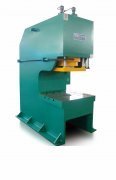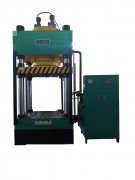Materials Used in Hydraulic Press Tooling
time:2023-03-17 views:(点击 973 次)
In a hydraulic press, fluid is continuously passed between two cylinders, eventually creating pressure that is then transferred onto an anvil, baseplate or die.
Hydraulic presses are widely used for compressing powder into compacted particles - this process is known as powder compaction and it's an invaluable aid to engineers and scientists creating new composite materials.
Carbon Steel
Carbon steel is one of the world's most beloved and commonly utilized metal alloys. It serves as a cornerstone in many industries, having been utilized in some of the world's tallest buildings for decades.
High carbon steel has superior tensile strength, making it popular in the manufacture of cutting tools, blades, punches, dies, springs and wire. Furthermore, due to its resistance to rust and toughness it finds many applications within industry.
Medium carbon steel is easier to machine and heat treat for hardness and tempering, making it an ideal material for structural applications such as buildings, bridges, axles, gears, shafts, rails and pipelines.
Low carbon steel is typically manufactured into flat-rolled sheets and strips for shipbuilding, wire, vehicle bodies, and domestic appliances. Due to its inert nature, heat treatment cannot alter it; hence it's often employed in fabrication and panelling projects.
Low-Alloy Steel
Alloy steel is a type of steel alloyed with various elements such as carbon, nickel, chromium, molybdenum and manganese to improve its properties. These alloying elements are added to the metal in order to increase strength, hardness, ductility and corrosion resistance.
Low-alloy steels contain a small percentage of alloying elements such as chromium, nickel and molybdenum (usually between 1% and 5%).
These steels can be employed in a variety of applications. They're frequently utilized in the production of ships, pipelines, pressure vessels and structural steel.
Steels of this type typically undergo heat treatment, normalizing and tempering. While they are weldable, some require pre- or post-weld treatments in order to prevent cracking.
Low-alloy steel such as 4140 is a common example, commonly used in power steering joints and other gears. It has many applications across various industries and can be heat-treated using various manufacturing processes.
High-Alloy Steel
Alloy steel is a type of metal alloyed with several elements to increase strength, hardness and wear resistance. These elements include molybdenum, manganese, nickel, chromium and vanadium.
Alloy metals are more resistant to oxidation and corrosion than other types of steel, as well as being stronger under shock loads and high-temperature stress.
High-alloy steels have many applications in industrial settings, such as aircraft, military vehicles and construction equipment. Their strong machinability and affordability make them popular choices for many companies.
High-alloy tool steel production is a complex process that involves powder metallurgy and hot isostatic pressing to achieve uniform distribution of eutectic carbide particles within the matrix. This results in a segregation-free steel suitable for complex or unconventional tool geometries.
When welding high-alloy steel, it is essential to use the correct welding process. Common techniques for high-alloy steel include gas metal arc welding (GMAW) and flux cored arc welding (FCAW). It is best to select a welder who has experience working with these materials.
Steel-Bonded Cemented Carbide
Steel-bonded cemented carbide is an extremely hard material with excellent strength and wear resistance, which can be cut, welded and forged. Its tensile strength exceeds that of high-speed tool steel but its bending strength falls short.
In hydraulic press tooling, cemented carbide is often combined with a hardened steel body. This hybrid structure creates tools with one part made of cemented carbide and the rest made up of hardened steel.
Cemented carbide tools require complex welding and joining processes, such as laser beam, tungsten inert gas (TIG), diffusion, and friction welding. Although these processes can be challenging to execute, they are necessary for creating cemented carbide tools. Successful joint design plays a significant role in these procedures - section thickness, seam placement, geometry of parts and restraint of welded joint.
Link to this article: https://www.ihydraulicpress.com/ht/1867.html
Hot Articles
-
How Can a Hydraulic Press Be Used For Wheel Bearing Recycling?
Hydraulic presses use hydraulic pumps to produce immense force using Pascal’s Law, and use this force to form metal or push against objects ag……
-
Safety Procedures For Using a Hydraulic Press
When working with hydraulic presses, there are some essential safety protocols that all employees should abide by. These include knowing the machi……
-
What is the Hydraulic Press Repair Time?
There are a number of factors that can affect hydraulic press repair time. By understanding these issues, you can ensure your business runs effici……
-
What is an Industrial Hydraulic Press?
Hydraulic presses are industrial tools used in a variety of industries, such as metalworking, agriculture, woodworking and plastics manufacturing.……
-
Hydraulic Press Automation System Repair Costs
Hydraulic presses are machines used to shape metal components. To produce quality parts, they require precise force, alignment and spacing. Hydrau……
-
Why Oil and Not Air is Used in Hydraulic Press Systems
A hydraulic press uses a pump to generate and transfer force, with two cylinders: a smaller slave cylinder and larger master cylinder, connected by ……
-
What details do I need to pay attention to when choosing a hydraulic press?
What details do I need to pay attention to when choosing a hydraulic press? In order to let the hydraulic press play a better use of functions and e……
-
Hydraulic Press Safety Procedures
Hydraulic presses are essential machinery in many industries. Unfortunately, their numerous uses and benefits come at the cost of serious safety ris……
Latest News
-
Hydraulic Press Operator Safety
Hydraulic presses are large machines designed to compress objects with a ram. They’re great for cutting or punching, drilling, straightening……
-
Safety Procedures For Using a Hydraulic Press
When working with hydraulic presses, there are some essential safety protocols that all employees should abide by. These include knowing the machi……
-
What Are the Advantages of Using a Hydraulic Press?
Hydraulic presses are machines used for compressing materials into larger shapes. They’re commonly employed in metalworking, food processing……
-
Hydraulic Press Automation Benefits
Hydraulic presses are powerful machines used in a range of industries. From metal forming to food packaging, they have become indispensable tools ……
-

影响齿轮泵工作压力的因素是什么
影响液压机齿轮泵工作压力的因素有哪些? 影响液压机齿轮泵研究工作环境压力不断提高的主要经济因素是:泄漏大(尤其是对于端面 泄漏,约占总泄漏量的70%~80%)、……
-
Disadvantages of Hydraulic Press Tooling
Hydraulic presses are powerful machines that use pressure to compress and shape objects. They have many metalworking applications, such as forming……
-

How do hydraulic press manufacturers install and debug hydraulic presses?
How do hydraulic press manufacturers install and debug molds? When the hydraulic press is put into use, the hydraulic press manufacturer needs to in……
-
How to Troubleshoot Hydraulic Press Automation System Issues
Hydraulic presses are commonly employed in a wide range of applications. As such, they require an effective press control system to operate at pea……














































